Human Orbital Spaceflights
![]()
International Flight No. 154STS-54Endeavour (3)53rd Space Shuttle missionUSA |
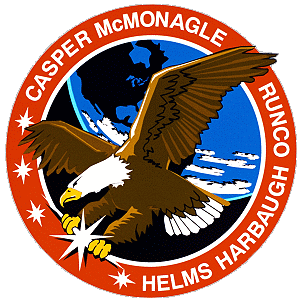 |
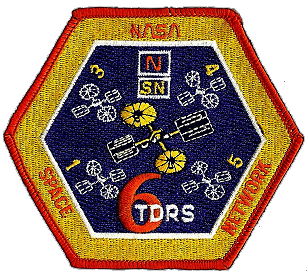 |
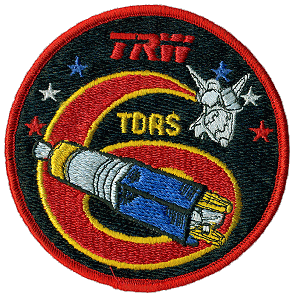 |
||
![]()
Launch, orbit and landing data
walkout photo |
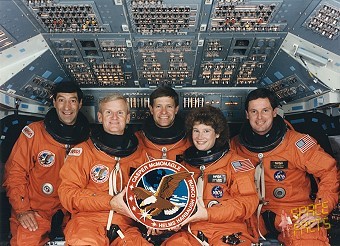 |
||||||||||||||||||||||||||||
alternative crew photo |
|||||||||||||||||||||||||||||
alternative crew photo |
|||||||||||||||||||||||||||||
alternative crew photo |
Crew
| No. | Surname | Given names | Position | Flight No. | Duration | Orbits | |
| 1 | Casper | John Howard | CDR | 2 | 5d 23h 38m 17s | 96 | |
| 2 | McMonagle | Donald Ray | PLT | 2 | 5d 23h 38m 17s | 96 | |
| 3 | Runco | Mario, Jr. "Trooper" | MS-1, EV-2 | 2 | 5d 23h 38m 17s | 96 | |
| 4 | Harbaugh | Gregory Jordan | MS-2, EV-1, FE | 2 | 5d 23h 38m 17s | 96 | |
| 5 | Helms | Susan Jane | MS-3, IV-1 | 1 | 5d 23h 38m 17s | 96 |
Crew seating arrangement
|
 |
|
||||||||||||||||||||||||
Hardware
| Orbiter : | OV-105 (3.) |
| SSME (1 / 2 / 3): | 2019 (11.) / 2033 (2.) / 2018 (9.) |
| SRB: | BI-056 / RSRM 29W |
| ET: | ET-51 (LWT-44) |
| OMS Pod: | Left Pod 03 (14.) / Right Pod 04 (10.) |
| FWD RCS Pod: | FRC 5 (3.) |
| RMS: | - |
| EMU: | EMU No. 2018 (PLSS No. 1014) / EMU No. 2015 (PLSS No. 1010) |
Flight
|
Launch from Cape Canaveral (KSC) and
landing on Cape Canaveral (KSC), Runway 33. The primary payload was the sixth Tracking and Data Relay Satellite (TDRS-F). Also carried into orbit in the payload bay was a Hitchhiker experiment called the Diffuse X-ray Spectrometer (DXS). This instrument collected data on X-ray radiation from diffuse sources in deep space. The Tracking and Data Relay Satellite System (TDRSS) was a space-based network that provided communications, tracking, telemetry, data acquisition and command services essential to the Space Shuttle and low-Earth orbital spacecraft missions. All Shuttle missions and nearly all NASA spacecraft in Earth orbit required TDRSS's support capabilities for mission success. TDRS-1 has exceeded its design life of 7 years and was continuing to provide limited services. TDRS-2 was lost in the Challenger accident. TDRSs 3-5 were operating, but only two were fully functional. In the event of a malfunction of one of these fully operational TDRS, the absence of a third fully operational satellite in ready reserve would severely impact orbiting customers for nearly a year before an emergency replenishment launch could be conducted. TDRSs were composed of three distinct modules - an equipment module, a communications payload module and an antenna module. The modular design reduced the cost of individual design and construction efforts that, in turn, lower the cost of each satellite. The equipment module housing the subsystems that operate the satellite was located in the lower hexagon of the spacecraft. The attitude control subsystem stabilized the satellite to provide accurate antenna pointing and proper orientation of the solar panels to the sun. The electrical power subsystems consisted of two solar panels that provided a 10-year power supply of approximately 1,700 watts. The thermal control subsystem consisted of surface coatings and controlled electric heaters. The payload module was composed of the electronic equipment required to provide communications between the user spacecraft and the ground. The receivers and transmitters for single access services were mounted in compartments on the back of the single-access antennas. The antenna module was composed of seven antenna systems: two single-access, the multiple access array, space-to-ground link and the S-band omni for satellite health and housekeeping. Commercial K-band and C-band antennas rounded out the complement. For single-access service, the TDRSs had dual-feed S-band, Ku-band parabolic (umbrella-like) antennas. These antennas were free to be positioned in two axes, directing the radio beam to orbiting user spacecraft below. These antennas primarily relay communications to and from user spacecraft. The high data rates provided by these antennas were available to users on a time-shared basis. Each antenna was capable of supporting two user spacecraft services simultaneously - one at S-band and one at Ku-band-provided both users are within the beam width of the antenna. The multiple access antenna array was hard-mounted in one position on the surface of the antenna module facing the Earth Another antenna, a 6.5-foot (2-meter) parabolic reflector, provided the prime link for relaying transmissions to and from the ground terminal at Ku-band. IUS-13, to be used on mission STS-54, was a two-stage rocket. Each stage had a solid rocket motor, preferred over liquid-fueled engines for their relative simplicity, high reliability, low cost and safety. The IUS was 17 feet (5.18 meters) long and 9.25 feet (2.8 m) in diameter. It consisted of an aft skirt; an aft stage solid rocket motor containing 21,400 pounds (9,707 kg) of propellant generating approximately 42,000 pounds (188,496 Newtons) of thrust; an interstage; a forward stage solid rocket motor with 6,000 pounds (2,722 kg) of propellant generating approximately 18,000 pounds (80,784 Newtons) of thrust and an equipment support section. TDRS-6 was deployed from Endeavour cargo bay approximately 6 hours after launch on orbit 5 over the Pacific Ocean north of Hawaii. Injection burn to geostationary orbit was initiated at 77 degrees east longitude (Indian Ocean, south of India), placing the satellite in orbit at 178 degrees west longitude (over the Pacific near the Gilbert Islands). Forward payload restraints were released and the aft frame of the airborne support equipment will tilt the IUS/TDRS to 29 degrees. This extended the TDRS into space just outside the orbiter payload bay, allowing direct communication with Earth during systems checkout. The orbiter then was maneuvered by John Casper and Donald McMonagle to the deployment attitude. Prior to deployment, the spacecraft electrical power source was switched from orbiter power to IUS internal power by the orbiter flight crew. After verifying that the spacecraft was on IUS internal power and that all IUS/TDRS predeployment operations have been successfully completed, a GO/NO-GO decision for IUS/TDRS deployment was sent to the crew. When the orbiter flight crew was given a GO decision, they activated the pyrotechnics that separates the IUS/TDRS umbilical cables. The crew then commanded the electromechanical tilt actuator to raise the tilt table to a 58-degree deployment position. The orbiter's RCS thrusters were inhibited and pyrotechnic separation devices initiated by Mario Runco to physically separate the IUS/spacecraft combination from the tilt table. Compressed springs provided the force to jettison the IUS/TDRS from the orbiter payload bay at approximately 0.10 meters (4.2 inches) per second. The tilt table was lowered to minus 6 degrees after IUS and its spacecraft was deployed. Approximately 19 minutes after IUS/TDRS deployment, the orbiter's engines were ignited to move the orbiter away from the IUS/TDRS. The belly of the orbiter was oriented towards the IUS/TDRS combination to protect the orbiter windows from the IUS's plume. The first burn of the IUS booster took place 1 hour after deployment or about 7 hours after STS-54 launch. The IUS second and final burn, to circularize the orbit, took place 5.5 hours after the first burn, approximately 12.5 hours into the mission. Separation of the booster and satellite occurred at 13 hours after launch. The Diffuse X-ray Spectrometer (DXS) addresses a fundamental question of present-day astrophysics - what is the origin and nature of the interstellar medium, the matter that fills the space between stars? The DXS studied the hottest components of the interstellar medium, gases at temperatures at approximately 1 million degrees Kelvin, by detecting the x-rays emitted there. By measuring the gas temperature and composition, the DXS provided important clues to the origin, evolution and physical state of this constituent of the Milky Way galaxy. The hot interstellar medium is one phase in the life cycle of the material in this galaxy. By studying this life cycle, the DXS scientists hope to learn more about the way the mass and energy of the galaxy are redistributed as it evolves. A better understanding of the evolution of the galaxy is one of the steps toward understanding the nature and evolution of galaxies, which contain most of the visible matter in the Universe. The DXS, developed by the University of Wisconsin, Madison, consisted of two identical instruments, one mounted to each side of the Shuttle cargo bay. A DXS instrument consisted of a detector, its associated gas supply and electronics. Each instrument was mounted to a 200-pound (91-kg) plate, which was attached to the side of the Shuttle bay. The DXS measured the arrival direction and wavelength of incident low energy x-rays in the wavelength range of 42 to 84 angstroms - an angstrom is one ten-thousandth of a millimeter. From this information, the DXS scientists will be able to determine the spectrum (brightness at each wavelength) of the diffuse soft x-ray background from each of several regions of the sky. While an EVA by Gregory Harbaugh and Mario Runco on January 17, 1993 (4h 28m) the astronauts performed a series of spacewalking tasks, including testing abilities of free moving, climbing into foot restraints without using their hands and simulated carrying large objects in the microgravity environment. During the STS-54 spacewalk, the astronauts evaluated how well they adapt to spacewalking, test their abilities to move about the cargo bay with and without carrying items, test the ability to climb into a foot restraint without handholds and test their ability to align a large object in weightlessness. To simulate carrying a large object, the astronauts carried one another: to evaluate how well large tools can be used, they worked with a tool already aboard Endeavour designed to manually raise the tilt table for the Tracking and Data Relay Satellite's Inertial Upper Stage booster; to simulate how well they can align an object, they attempted to place each other into the brackets in Endeavour's airlock that hold the spacesuit backpacks when not in use. CHROMEX-4 was designed to gain an understanding of the reproductive abnormalities which apparently occur in plants exposed to microgravity, and to determine whether changes in developmental processes may be due to spaceflight conditions, especially microgravity. This experiment also will help understanding how gravity influences fertilization and development on Earth. The effects of microgravity on the seed production of Arabidopsis thaliana were studied. Arabidopsis thaliana is a small, cress-type plant with white flowers. Its small size, small genome and short life cycle (45 days) made it ideal for gene mapping studies. It was chosen because it is small enough to fit in the flight hardware, and its rapid life cycle and numerous flowers will ensure that a maximum number of reproductive stages can be observed in a limited number of plants. Arabidopsis seeds were planted preflight so that 14-day-old plants, capable of producing seeds, can be flown. These plants were flown inside the Plant Growth Unit (PGU), a closed system that provided day/night lighting located in the orbiter middeck. The PGU hold six Plant Growth Chambers (PGCs), each of which contained six plants. The PGCs provided structural and nutritional support to the plants while on orbit. During the STS-54 mission, the Commercial Generic Bioprocessing Apparatus (CGBA) supported 28 separate commercial investigations, loosely classified in three application areas: biomedical testing and drug development, controlled ecological life support system (CELSS) and agricultural development and manufacture of biological-based materials. Biomedical Testing and Drug Development: To collect information on how microgravity affects biological organisms, the CGBA included 12 biomedical test models. Of the 12 test models, five are related to immune disorders. One investigated the process in which certain cells engulf and destroy foreign materials (phagocytosis); another studied bone marrow cell cultures; two others studied the ability of the immune system to respond to infectious-type materials (lymphocyte and T-cell induction) and one investigated the ability of immune cells to kill infectious cells (TNF-Mediated Cytotoxicity). The other seven test models - which were related to bone and developmental disorders, wound healing, cancer and cellular disorders - investigated bone tissue formation, brine shrimp development, pancreas and lung development, tissue regeneration, inhibition of cell division processes, stimulation of cell division processes and the ability of protein channels to pass materials through cell membranes. The second Physiological and Anatomical Rodent Experiment (PARE.02) was a secondary payload flight experiment located in a Space Shuttle's mid-deck locker. The goal of PARE.02 was to determine the extent to which short-term exposure to microgravity alters the size, strength and endurance capacity (stamina) of skeletal muscles normally used to help support the body against the force of gravity. The purpose of the Solid Surface Combustion Experiment (SSCE) was to study the physical and chemical mechanisms of flame propagation over solid fuels in the absence of gravity-driven buoyant or externally-imposed airflows. The controlling mechanisms of flame propagation in microgravity are different than in normal gravity. On Earth, gravity causes the air heated by the flame to rise. This air flow, called buoyant convention, feeds oxygen to the flame and cools the fire, creating competing effects. In microgravity, this flow is absent. Therefore, the fire is sustained only by the oxygen that it consumes as it migrates along the fuel's surface. The results of the SSCE have a practical application in the evaluation of spacecraft fire hazards, as well as providing a better understanding of flame propagation in microgravity and on Earth. The experiment consisted of two parts - the chamber module and the camera module. The chamber module consisted of a sealed combustion chamber which housed the sample and was filled with a combination of oxygen and nitrogen. The chamber had two perpendicular viewports - one on the side and one on the top. Ashless filter paper was tested on the first five flights with different mixtures of oxygen and nitrogen and with varying pressures. The final three tests used polymethylmethacrylate (PMMA), commonly known as Plexiglas. Typically, one configuration was tested per mission. For this mission, the chamber contained a 35:65 ratio by volume of oxygen to nitrogen at a total pressure of 1.0 atmosphere. Another middeck payload to test the effects of microgravity was the Space Acceleration Measurement Equipment (SANS) to measure and record the microgravity acceleration environment of middeck experiments. Also, a new onboard-toilet was tested. |
EVA data
| Name | Start | End | Duration | Mission | Airlock | Suit | |
| EVA | Harbaugh, Gregory | 17.01.1993, 10:50 UTC | 17.01.1993, 15:18 UTC | 4h 28m | STS-54 | Endeavour | EMU No. 2018 |
| EVA | Runco, Mario | 17.01.1993, 10:50 UTC | 17.01.1993, 15:18 UTC | 4h 28m | STS-54 | Endeavour | EMU No. 2015 |
Photos / Graphics
 |
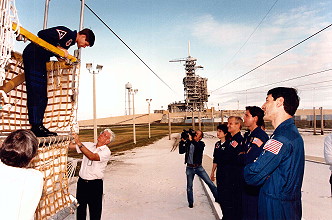 |
 |
 |
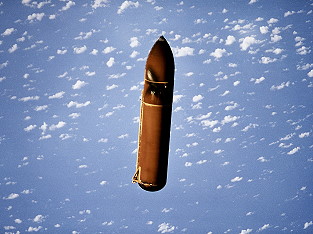 |
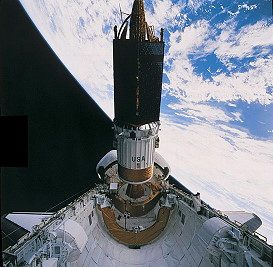 |
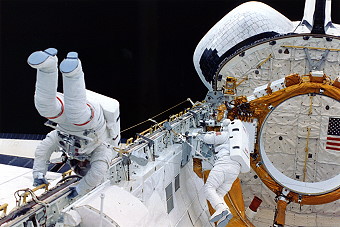 |
 |
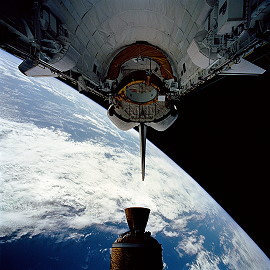 |
 |
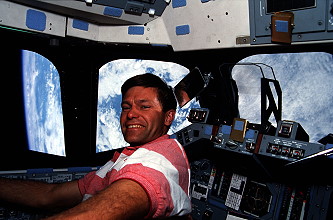 |
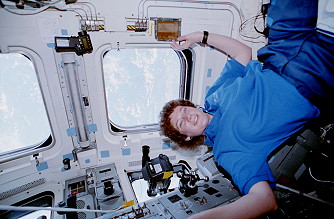 |
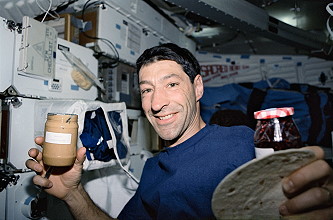 |
 |
more EVA photos |
|
| © |  |
Last update on March 27, 2020.  |
 |